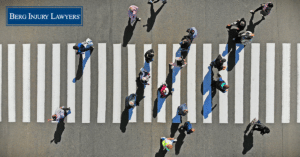What are California’s Crosswalk Laws?
| May 25th, 2020
 California’s road laws aren’t just for motorists. Pedestrians have clear rights and laws they must follow, too.
It’s important for both drivers and pedestrians to understand the laws (and best practices) for navigating intersections, which is why we’re giving pedestrians the lowdown on California’s crosswalk laws.
California’s road laws aren’t just for motorists. Pedestrians have clear rights and laws they must follow, too.
It’s important for both drivers and pedestrians to understand the laws (and best practices) for navigating intersections, which is why we’re giving pedestrians the lowdown on California’s crosswalk laws.
So, What Are California’s Crosswalk Laws?
CVC §21950 says that drivers should yield the right-of-way to a pedestrian crossing the roadway within any marked crosswalk or within any unmarked crosswalk at an intersection. However, there are a couple of important caveats. California’s law does not absolve a pedestrian from the duty of “using care” for their safety. The statute says that “no pedestrian may suddenly leave a curb or other place of safety and walk or run into the path of a vehicle that is so close as to constitute an immediate hazard. No pedestrian may unnecessarily stop or delay traffic while in a marked or unmarked crosswalk.” The remainder of the statutes in this law pertain specifically to the responsibilities of drivers. It states that drivers approaching a pedestrian within “any marked or unmarked crosswalk shall exercise all due care and shall reduce the speed of the vehicle or take any other action” required to keep pedestrians safe.What Does That Mean for Pedestrians?
California’s pedestrian law is somewhat at odds with commonly held wisdom that pedestrians always have the right-of-way, but it doesn’t absolve drivers from their share of responsibilities, either. It’s true that pedestrians using crosswalks have the right-of-way, but from both a legal and safety standpoint, it’s important not to stop in the middle of that crosswalk, if at all possible. Some of the other language used in the statute is also open to interpretation. For example, the laws states that pedestrians shouldn’t “suddenly leave a curb into the path of a vehicle” in a way that presents an “immediate hazard.” Terms like “suddenly” and “immediate hazard” introduce ambiguity into an otherwise clear-cut law. As you can imagine, this ambiguity is a focus for attorneys who are representing clients in cases involving pedestrian collisions on both sides of the issue.The Legal Implications of a Pedestrian Collision
If a pedestrian is injured by a driver and files a legal claim, it’s possible the driver’s attorney will argue that the pedestrian walked into the street without warning, even if the pedestrian believes it would be obvious to any responsible driver that they were crossing the street. This highlights the need for an experienced attorney when a legal dispute emerges from a pedestrian collision. An injured pedestrian will likely need an advocate to make their case using all available facts. An injured pedestrian’s attorney might look for several types of evidence to back up their client’s argument. For example, security or street cameras might have captured footage of the accident, which can be used to reinforce the pedestrian’s claim. An attorney could also ask any eyewitnesses for their account of the collision.What Can Pedestrians Do to Stay Safe?
Pedestrians can keep these safety tips in mind when walking near or across roads:- Whenever possible, use sidewalks and designated crossings.
- Whether or not you’re using a designated crossing, be mindful of oncoming traffic and, when possible, try to make eye contact with drivers to ensure they see you.
- If walking at night, wear brightly colored or reflective clothing.
- If no sidewalk is available, walk facing traffic while maintaining a safe distance from the road.
What Are Driver’s Responsibilities Near Pedestrians?
Drivers must follow all the rules of the road to keep pedestrians safe. They can further protect pedestrians by following these guidelines:- Always give pedestrians the right-of-way.
- Slow down when near crosswalks or in areas where pedestrian traffic volume is high.
- Never pass a vehicle when it is stopped at an intersection or crosswalk.
- Never come to a stop in a crosswalk.
- If a pedestrian makes eye contact with you, assume they’re crossing the street.
- Give vulnerable pedestrians (elderly or disabled people) more time to cross the street.


